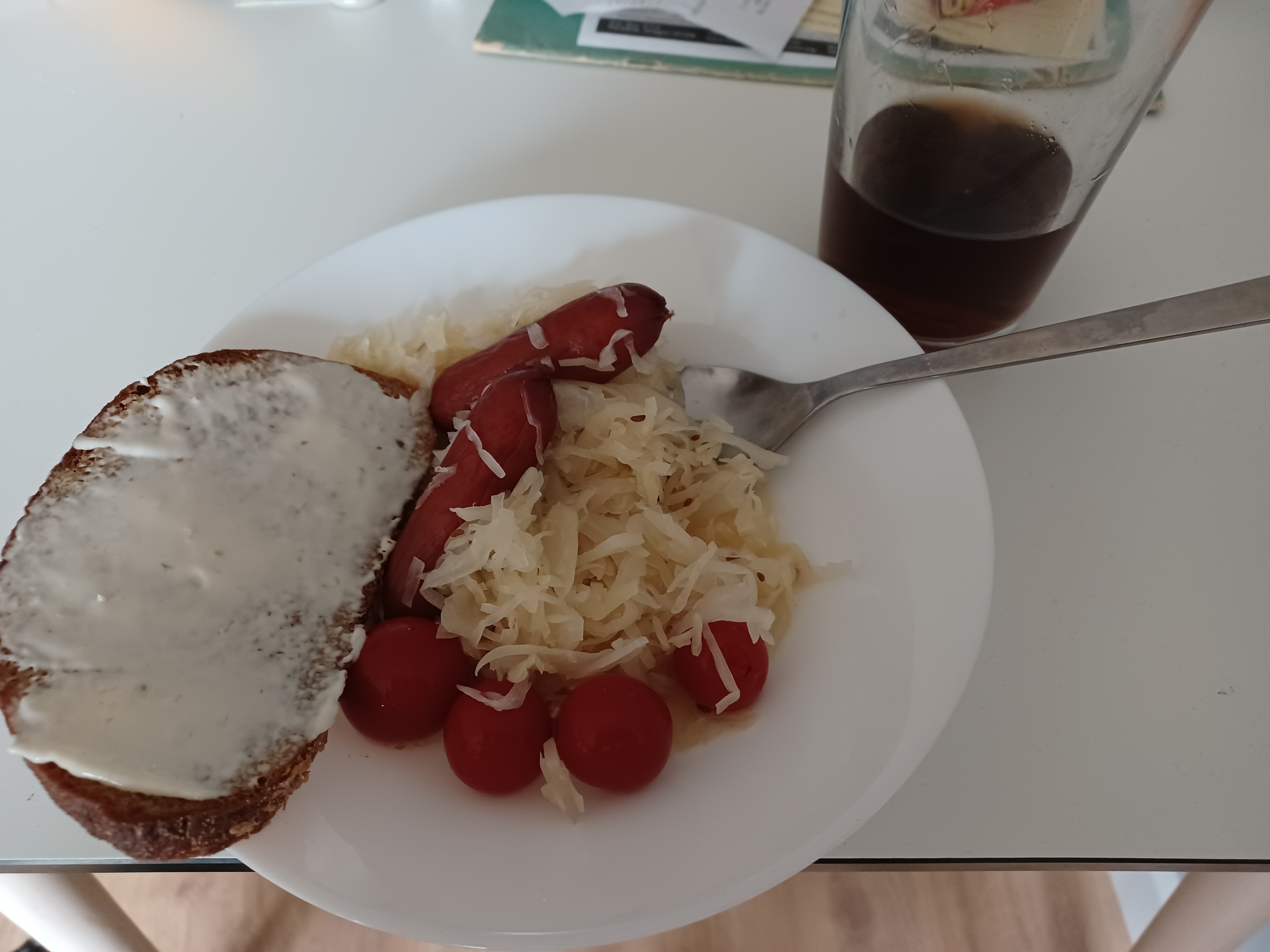Lunchtime
Today, I looked down at my lunch and realized it seemed to have an especially Latvian quality, so I thought I’d make a quick post about it. I’m slowly putting together a bigger post about the Latvian grocery store, so if you’re interested, stay tuned for more Latvian foods and grocery items.

Anyway, here I have an assortment of things I quickly threw together from the fridge; hardly gourmet, but let’s see what we have.
First, we have the heart of the dish: some home-fermented cabbage from Christina’s aunt. It’s essentially sauerkraut, but crunchier in texture than varieties I’m used to. It’s obviously flavored with caraway, but I’m not sure what else.
Christina’s aunt is a very sweet lady, and like my own mother often does she sent us home with jars of homemade preserves and various home-canned items from her pantry. When she offered up this sauerkraut, she pulled a two-gallon (or larger?) jar from the pantry and scooped some of its contents into a plastic tub. We could tell the fermentation process was still at work because escaped gases kept popping the top off the plastic tub, maybe this is why it is crunchier than usual.

On top of the cabbage I threw a couple sausages – 85% meat, yikes! Actually, these seem like pretty typical smoked pork sausage links you’d find in US grocery stores.
This particular variety is produced “with love from Latgale.” The Latgale region of Latvia is the easternmost part of the country. It contains Latvia’s second largest city, Daugavpils, but is otherwise largely agricultural. It strongly reminds me of northern Minnesota; full of farms, lakes, birch forests, and gravel country roads.
This variety is also partially dried. I’m not sure why this would be done, maybe to increase shelf-life, but they plump up nicely when steamed over sauerkraut.

I garnished my kraut and sausages with some marinated cherry tomatoes. These particular ones are actually from Ukraine, but Latvia also produces a large variety of marinated/pickled vegetables. Some of you may have noted the pickled pumpkin from the Christmas post. Christina doesn’t care much for pickles, although she seems to like pickled beets, but I’m in heaven. Anyway, these are delicious, and I hear they can take down enemy drones 😉

It can’t really be called a Latvian meal without rye bread. If there’s one thing that Latvia does better than the US, it’s bread. The grocery stores sell a dizzying variety, and so far, they’ve all been delicious. But, for everyday use, this is my favorite.
Saldskābā maize, or literally, sweet and sour bread, is a traditional Latvian rye bread leavened with sourdough. Traditionally, it was made with 100% rye flour that was “scalded” (to improve texture) in wood tubs made of aspen (to improve aroma and flavor), and served during holidays.
This particular commercial loaf is made with a blend of rye and wheat flours and has added yeast. It’s still delicious, so I can imagine that the traditional loaf must be out of this world.

This is probably sacrilegious, but I topped that delicious bread with a cheese spread. Kausētais siers, or “melted cheese” is a type of processed cheese spread that is extremely popular in Latvia. This one is made “with ham”, but I think I prefer the classic flavor. There is also a pepper and a shrimp flavored version.
This particular brand is called Dzintars, which means “amber.” The Baltic states are famous for their amber, which I’m told can still sometimes be picked directly off the beaches of the Baltic sea. The tourist souvenir shops are full of amber jewelry and other trinkets, but most of it seems to come from Kaliningrad, not Latvia.

And finally, I washed it all down with a refreshing glass of kvass (prounounced “kwoss”). Kvass is a soft drink produced from fermented rye and barley. Although fermented, commercial kvass is not allowed to exceed 1.2% alcohol and is widely available in grocery store soft drink aisles.
Its flavor is hard to describe but is vaguely reminiscent of cola. There are also many varieties that have added fruits or herbs. It’s so wildly popular in Russia that in order for Coca-Cola to compete with the market they were forced to make their own version. During the Soviet occupation of Latvia, kvass was commonly sold by street vendors, each hawking their own special recipe. Some restaurants still produce their own craft brews. Homemade kvass is often made using leftover bread and bread crusts and then flavored with spices, peppermint, dried fruit, or I’ve even heard of hops. I haven’t had the opportunity to try a home-brew yet, but you can bet I won’t pass up the chance.
Labu apetīti!





Sounds/looks really good!
Hey Randy, Lilly sent me this link and I am glad she did, because I have been thinking about you and your wife, if the situation in Ukraine had affected you guys. I am glad that you are doing well, you are not missing much, other than the typical unrealistic deadlines at BC…so enjoy and be safe.
Alex
Hi Alex! I should probably do a quick post about Ukraine, but for all intents and purposes life here is unaffected. I’m of course anxious about the situation and monitoring it closely while bouncing from anger to despair in the process. Thanks for the comment!
Hey Randy! I love the backstories and descriptions. Hope you & Christina are having a great time exploring and perhaps playing/listening to Latvian music? Jums ļoti pietrūkst. Take care!
Hi Lilly! Thanks for visiting! I think a Latvian music post is in the works. We watched the Zelta Mikrofons (Latvia’s version of the Grammy awards) couple weeks ago and there’s some good stuff being made in Latvia. Stay tuned!
Aww, SO good to hear from you! Yes, a music post would be great! Any good electronic music out there?
As far as I can tell, good stuff coming from all genres. I’m never sure what people mean by “electronic music” but here’s a preview: https://www.youtube.com/watch?v=ioHmj9E-j1I&list=PLtGq_6p_7zC77UsWMmO3HN-Sew7nKQYVJ&index=17
I think I would like this! Although I don’t think my Doctor would.
Hey Eric! Did you all get together at the same time and post comments? Thanks for the comment!
Hey Randy, great to see that you’re doing well. Kvass is definitely delicious, was recently on a hunt to buy some kvass concentrate to make it at home.
Hi Max!
Thanks for commenting! I had no idea you could find concentrate. I’ll have to look for it in the store.